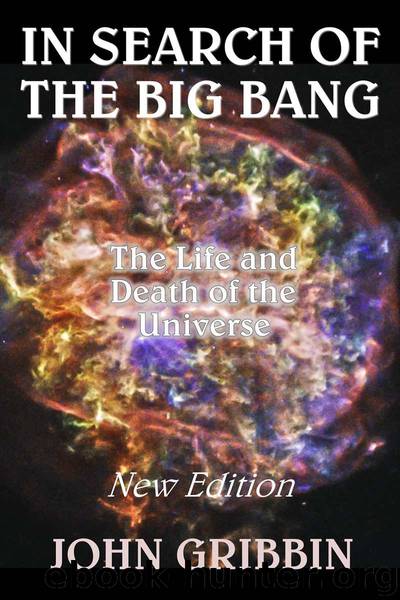In Search of the Big Bang by John Gribbin

Author:John Gribbin
Language: eng
Format: mobi, epub, azw3
Publisher: ReAnimus Press
Published: 2015-01-11T22:00:00+00:00
The next 10 billion years
A little more than half an hour after t = 0 (at t = 34 minutes and 40 seconds, to be precise), almost all of the electrons and positrons have been annihilated, and the Universe has begun to resemble the empty state we find it in today. Almost, but not quite, all of the matter has gone. In addition to the billionth part of the number of photons that is present as nucleons, when the electron-positron pairs finally annihilate, just one electron in a billion is also left over, exactly the amount required to balance the positive charge on all the protons in the Universe, and to ensure that eventually the matter will settle out as stable, uncharged atoms, with every proton in every atomic nucleus matched by an electron in the cloud on the outside of the atom. Where does this tiny proportion of matter come from? Why isn’t there a perfect symmetry between particles and antiparticles, so that everything annihilates and only radiation is left as the Universe cools? The answers emerge from an understanding of the world of particle physics under conditions even more extreme than those during the epoch of the life of the Universe following the first hundredth of a second, and they are among the simplest, but also most profound, of the puzzles resolved by the discoveries described in later chapters. For now, though, let’s stick with the expanding, cooling fireball half an hour after the moment of creation.
By now, the temperature of the fireball is down to 300 million K, and the energy density of the Universe is only 10 per cent of the mass density of water. About 69 per cent of this energy is carried by photons and 31 per cent by neutrinos, and the expansion timescale appropriate at this time has stretched to 75 minutes. Although all the available neutrons have been cooked into helium nuclei, the Universe is still too hot for stable atoms to form—as soon as a positively charged proton or helium-4 nucleus latches on to a negatively charged electron, the electron is knocked out of its grip by an energetic photon. This is the ‘radiation era’ of the Universe, with no significant particle interactions to worry about, and with the remaining matter dominated by the radiation. It lasts for about 700,000 years, until the temperature drops to about 4,000 K and the nuclei and electrons are at last able to hold together against the ever-decreasing battering they receive from photons.
The time at which this occurs is not well defined. As early as 300,000 years after the moment of creation some hydrogen atoms are beginning to form and survive for a reasonable length of time without being ionized by the radiation; after t = 106 years, all of the electrons have been bound up in atoms, so efficiently that only one electron and one proton are left out on their own for every 100,000 stable atoms, and the ‘decoupling’ of matter from radiation is complete.
Download
In Search of the Big Bang by John Gribbin.epub
In Search of the Big Bang by John Gribbin.azw3
This site does not store any files on its server. We only index and link to content provided by other sites. Please contact the content providers to delete copyright contents if any and email us, we'll remove relevant links or contents immediately.
Tools of Titans by Timothy Ferriss(8218)
Turbulence by E. J. Noyes(7936)
Secrets of Antigravity Propulsion: Tesla, UFOs, and Classified Aerospace Technology by Ph.D. Paul A. Laviolette(5309)
Astrophysics for People in a Hurry by Neil DeGrasse Tyson(5133)
Room 212 by Kate Stewart(5037)
Design of Trajectory Optimization Approach for Space Maneuver Vehicle Skip Entry Problems by Runqi Chai & Al Savvaris & Antonios Tsourdos & Senchun Chai(5011)
Pale Blue Dot by Carl Sagan(4912)
The David Icke Guide to the Global Conspiracy (and how to end it) by David Icke(4625)
A Journey Through Divination and Astronomy by Publishing Pottermore(4344)
Goodbye Paradise(3727)
Apollo 8 by Jeffrey Kluger(3637)
COSMOS by Carl Sagan(3554)
Losing the Nobel Prize by Brian Keating(3499)
The Five People You Meet in Heaven by Mitch Albom(3475)
How to Read Water: Clues and Patterns from Puddles to the Sea (Natural Navigation) by Tristan Gooley(3408)
Brief Answers to the Big Questions by Stephen Hawking(3369)
How to Read Nature by Tristan Gooley(3249)
The Order of Time by Carlo Rovelli(3145)
A Brief History of Time by Stephen Hawking(2961)
